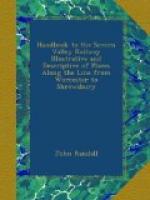DROITWICH.
Population, 3,123
Market day—Friday. Fairs—Friday in Easter week, June 18th, September 24th, and December 18th.
The town, which lies beneath the embankment of the railway, in the valley of the river Salwarp, on the right, is on weekdays so enveloped in steam, that little beyond its stacks, and the murky tower of St. Andrew’s Church, are seen. Its staple trade is salt, for the export of which the canal, the Severn, and modern railways offer great facilities. From early times, the subterranean river beneath the town has yielded an uninterrupted supply of the richest brine in Europe; and it is curious to observe how the vacuum created by the amount raised has caused the ground to collapse and crack, as shown by the decrepit state of the buildings, many of which are broken-backed, twisted, and contorted—although the intermediate earth is about 200 feet in thickness. The place, therefore, has a sort of downcast look, and the streets have a melancholy appearance; whilst the sheds of the brine works, made to appear more murky by contrast with heaps of white salt refuse, suggest the thought that the town has gone into mourning. Exception must be taken to St. Peter’s Church, which stands outside the town, and is surrounded by green fields, with no building near, except an exceedingly dilapidated half-timbered mansion, the property of Lord Somers. Tradition says that this church once adjoined the town, but that the latter shifted in the direction of the springs; if so, the injunction over the doorway, to “Remember Lot’s wife,” seems a strange rebuke, if intended for the inhabitants. The building has many features of interest, the Norman, the Transition, and subsequent styles of architectural decoration being observable.
[Westwood house: 10.jpg]
The old town has an interesting charity, founded by Lord Coventry, for the support of poor people, and the education of poor children. The almshouses, which have recently been rebuilt, and are eighteen in number, are commodious and convenient, with garden plots at the back; whilst the inmates have 3_s_. 6_d_. per week, or 5_s_. if upwards of 70 years of age, beside clothing. Connected with these is an infirmary, in which at the time of our visit were three old ladies, who looked particularly clean and comfortable, and whose ages were respectively 83, 89, and 93.




